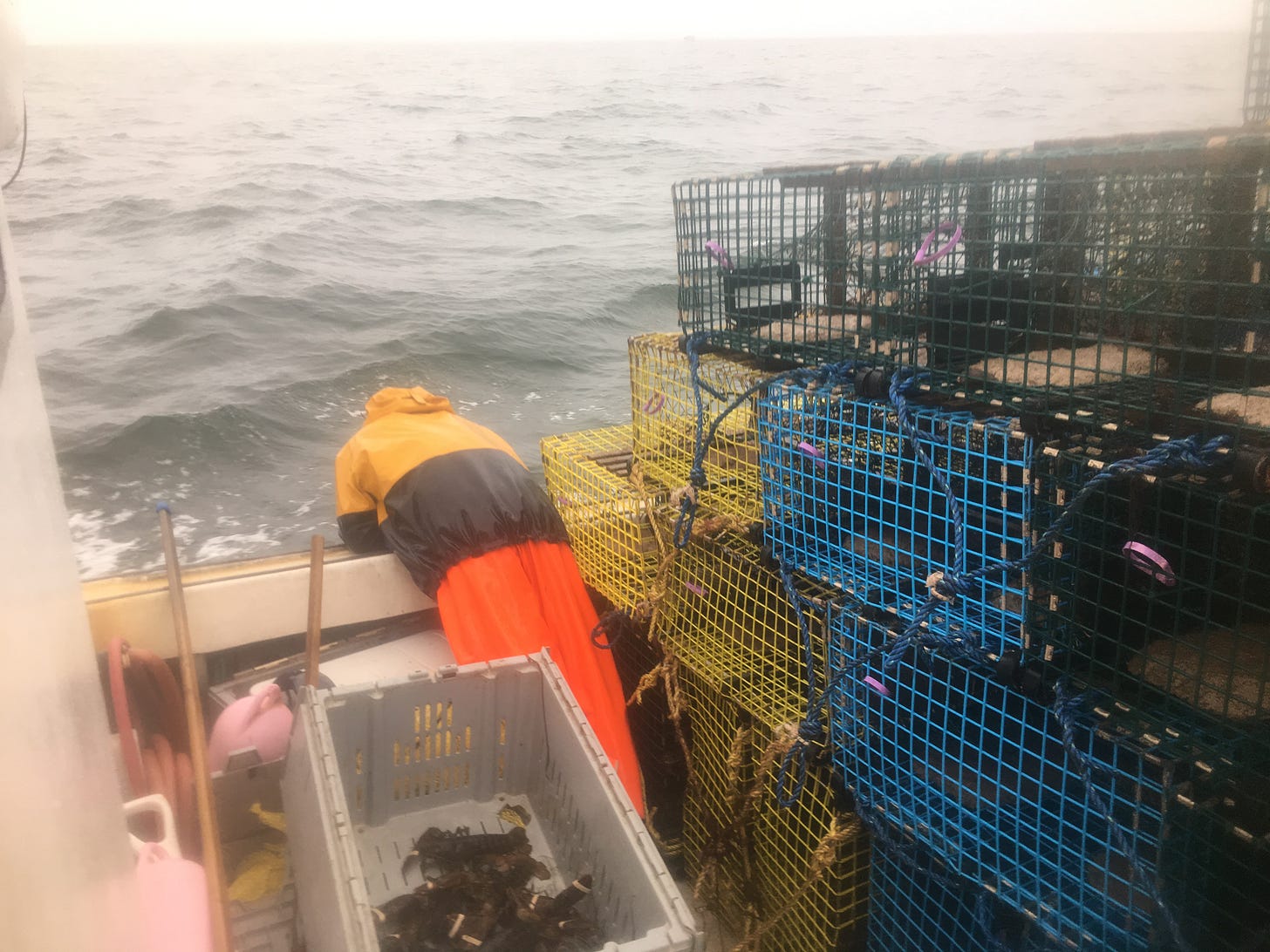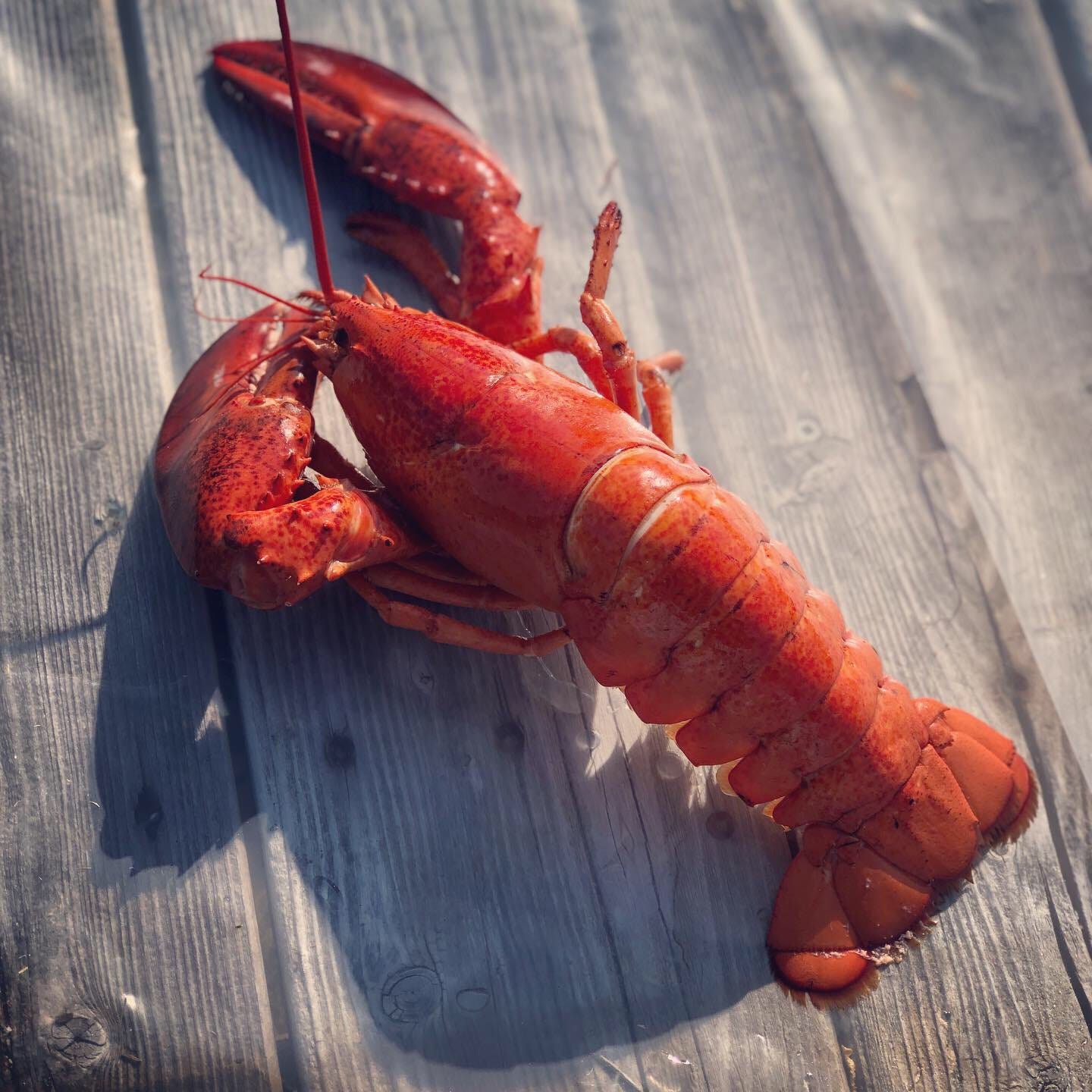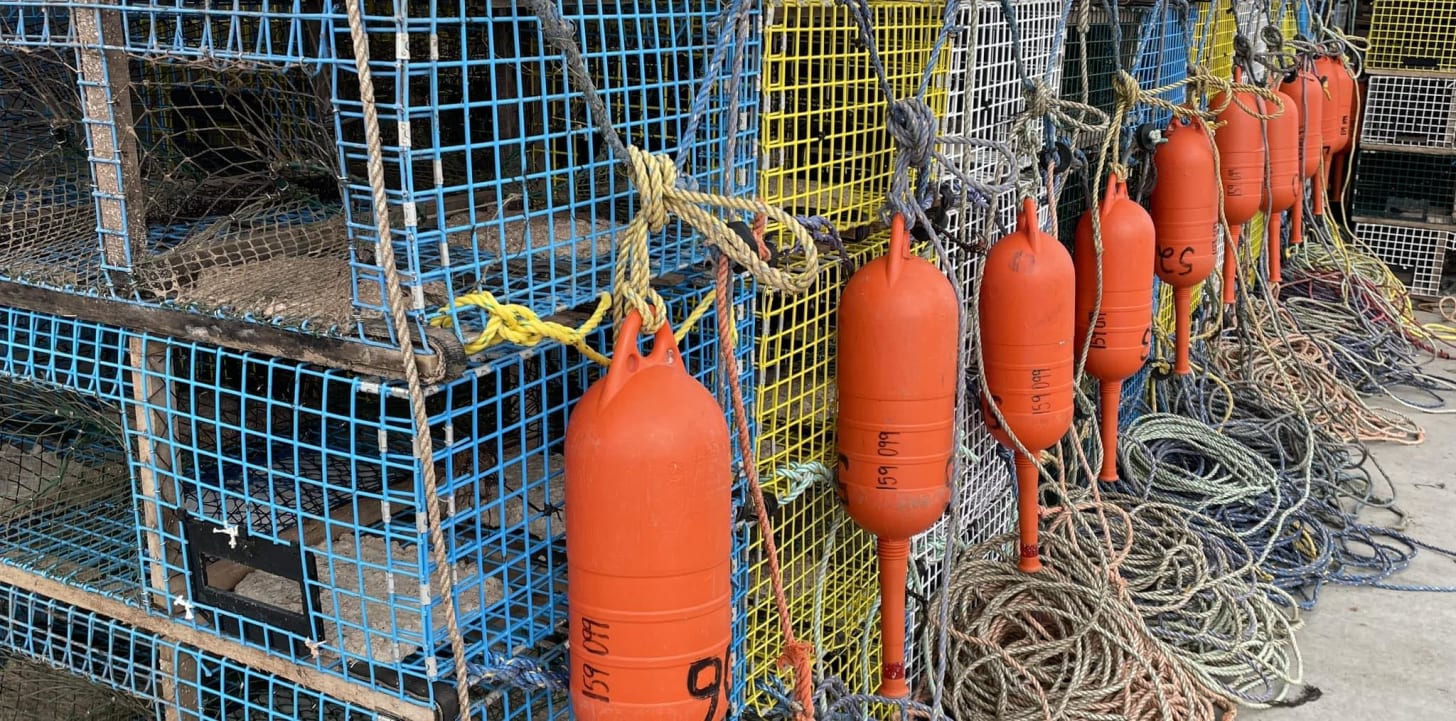Markets and Canners
Sun or swells, the lobster traps need to be cleaned and reset.
The wakeup call came early on the first full day that I ever spent in Nova Scotia.
When Hayley and I rolled out of bed at 3 a.m., my future father-in-law, Nipsy, was already scrounging around in the kitchen upstairs. I couldn’t tell if he was talking to himself or the dogs. Maybe a little of both.
Then again, I could have been hearing voices. Hayley and I got in around supper time the day before after a three-day, 2,000-mile (3,220 km) drive from Saint Peter. We went to bed early but it took awhile for me to fall asleep after all the excitement of arriving in Pictou for the first time. Throw in the two-hour time difference from Minnesota and the dark basement bedroom, and I hardly even knew where I was.
I put on pair of gym shorts and an old football t-shirt and headed upstairs.
“Coffee, TJ?” Nipsy asked.
I squinted at the kitchen lights, rubbed an eye, and grunted something that must’ve sounded affirmative.
“Fill your boots.” He nodded to the pot on the stove, then disappeared out the door.
I poured a cup and dropped in two ice cubes. I blew across the top and took a sip.
Holy shit.
That woke me up, alright. I wondered if it was some kind of marine-grade industrial stuff he’d ordered along with oil filters and fuel-line cleaner. I didn’t know if it had been created in a lab or brewed through copper tubing somewhere deep in the woods.
I tried another sip. Now that I knew what to expect, I kind of liked it.
Hayley came upstairs a few minutes later. I was pacing back and forth in the living room, eyes double-bloodshot from the lack of sleep and concentrated caffeine.
I hoisted a pair of rubber boots in the air with one hand.
“What’s wrong with you?” she asked.
I shook a thermos at her with the other.
“Your dad tried to poison me but I’m too strong.”
She rolled her eyes.
“Let’s go fishing,” I said.
We pulled into Caribou Wharf after the 10-minute drive from Pictou. Navigational lights and floods snapped on as diesel engines coughed to life. Captains and helpers hauled fish trays filled with frozen bait down from the wharf and stacked them on the decks of the boats.
Nipsy and his helper, Eddie Lyons, were already aboard the Hayley and Noah. The boat was tied up outside Sea Mist Again, which is captained by one of Nipsy’s best friends, Clinton. Hayley climbed down the ladder and walked across the transom to the boat that bore her name.
I hesitated for a second, then followed.
There I was, clambering over a concrete wall and balance-beaming across a gunwale, all of this taking place literally at the end of the road where a spur of the Trans-Canada Highway runs into the ocean. No warning signs except on the fuel tanks and garbage bins. Diesel exhaust, cigarette smoke, and salt spray mixed in the humid pre-dawn air. This is pretty damn cool, I thought.
I jumped onto the deck of the Hayley and Noah.
Hayley was wearing pink rubber oilskins. She introduced me to Eddie for the first time.
“Should be a good day,” Eddie said, “Weather looks A-1.”
“Put those on, DJ,” Nipsy said, pointing to a pair of blaze orange rubber overalls that matched Eddie’s and his own.
They fit just fine, I thought.
We joined the swarm of lobster boats sailing out of the wharf at 4 a.m.
Out on the bottom of the ocean sat Nipsy’s 280 lobster traps. They were grouped in 56 trawls. Each trawl consists of five traps strung along a length of rope that has a colored buoy on each end. We motored up to one of the buoys. Nipsy locked onto it with a spotlight and Eddie reached out to snag the rope with a gaff. He hauled up the first few feet by hand, then passed the line to Nipsy, who strung it over a pulley then secured it in the hauler that would drag the traps up to the boat. When a trap reached the surface, Nipsy bent down, grabbed it from the water, and pulled it up onto the port gunwale.
From there, Eddie went to work, quickly opening the trap, pulling out lobster, removing the old bait, rebaiting the trap, then sliding it down the rail. He was a one-man assembly line.
If a lobster was too small, it went back over the edge. Female lobsters carry their eggs curled under their tail. If you saw even one egg hidden under there, the lobster went back in the sea. Once all five traps were cleaned and filled with new bait, Nipsy hit a button to release the trawl back into the water.
Eddie didn’t wait. As soon as the last trap was ready, he spun around to the sorting table where he’d been putting the lobsters that warranted a closer look. He reached into a bucket of rubber bands, emerging with one clamped around the end of the pliers-like tool. He snapped the rubber band around a lobster’s claw, then repeated the process. Eddie measured the back of the lobster with a metal measuring tool that hung from the table by a string. If it was big enough, it was a “market” lobster—the kind you see in restaurants and that draw a higher price at the wharf. If they were smaller but still legal size, they went in the “canner” tank. These lobsters would most likely be used for processed seafood products.
We watched carefully as Eddie handled the first trawl, then Hayley stepped in to help band the lobster claws. That left me on bait duty.
Once Eddie had plucked the lobster, he slid the metal trap down the gunwale. I reached in with a pair of thick rubber gloves, pulled the old, chewed-up bait out of the trap and tossed it overboard. I replaced it with a mackerel that I’d cut into three pieces, then closed the trap and slid it down the rail. It wasn’t so bad in the morning, when the hardest part was cutting the frozen fish. But as the day wore on and the bait fish thawed, it became a dirtier, stinkier job.
The sun came up over the Northumberland Strait as we worked. After awhile, it was time for a break. Nipsy heated up breakfast sandwiches and coffee on the stove down in the berth.
I switched to lobster banding.
“Be careful of the claws,” Eddie warned. “They’ll pinch you if they can.”
We had a full boat by the time we finished our last trawl and started making our way back to Caribou.
It had been a great day on the water. Sure, it was hard work, but the sun, calm seas, and crowded traps made the time pass quickly.
A couple days later, I decided to go out again. Hayley stayed home. Nipsy had said it would be a little windy.
It turns out I should’ve asked a few more questions about the forecast.
I spent most of the trip hanging over the side of the boat feeding the fish. Between bouts of sea-sickness, I helped band lobster and stack traps. It was “hauling day,” so we were pulling the traps out for the season, filling the back of the boat, and bringing them back to the wharf.
“You’re doing great, buddy,” Eddie said. It didn’t feel like it. “Nipsy’s had a bunch of guys who get sick and just curl up in the cabin and quit. Good on ya for keeping at’er.”
The truth is, I felt the best I did all day in the 30 minutes after each time I puked. I figured I might as well make the most of the time by working.
We got back to the wharf to drop off the first load of traps. A teenage kid Nipsy had hired was standing on the wharf. He’d overslept and missed the boat earlier.
“JJ, trade with him and get some sleep,” Nipsy said. He pressed his car keys into my hand. I half-heartedly protested, then gratefully climbed the ladder to solid ground.
When I got back to the house, I collapsed into bed. I’d been sick seven or eight times and was exhausted.
“How’d it go?” Hayley asked when she got home from her run.
“It was a tough day,” I answered. “But I think I did alright.”







Wonderful, DJ, JT, JJ! I love the authentic voices.
Whyyy have I not seen this picture before?! Hahaha
You are a good sport